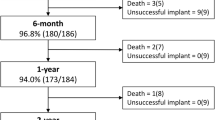Abstract
Device migration is one of serious complications in neonates and infants undergoing transcatheter closure of the patent ductus arteriosus (PDA). We hypothesize that neonates and young infants possess the distensibility of the ductus, which may be related to device migration. We retrospectively reviewed angiographic findings in 41 neonates and infants who underwent transcatheter closure of PDA. We measured diameters of the ductus at the pulmonary (PA) side, the center, and the aortic (AO) side before PDA closure, and the device center diameter after device closure. The distensibility index was defined as the ratio of the device center diameter after device deployment to the diameter at the center of the ductus before PDA closure. Age and weight at the procedure were 168 (117–260) days and 5.3 (4.3–6.9) kg, respectively. Thirty-seven subjects accomplished the successful device closure, and four subjects were declined because of the device instability or migration. Implanted devices included Amplatzer Duct Occluders in 33 subjects and Amplatzer Vascular Plug-2 in 8 subjects. The PDA diameters at PA side, at the center, AO side, and the device center diameter were 3.2 (2.2–4.3) mm, 4.7 (3.6–5.7) mm, 7.7 (6.3–9.4) mm, and 5.8 (4.2–6.9) mm, respectively. The PDA diameter before closure was not correlated age and weight. The distensibility index was 1.28 (1.06–1.64), which was significantly correlated to age (r = − 0.49, P = 0.001) and weight (r = − 0.53, P < 0.001). Infants with the younger age and the lower weight have the more distensible PDA, which may be a risk for device migration.


Similar content being viewed by others
References
O’Byrne ML, Millenson ME, Grady CB, Huang J, Bamat NA, Munson DA, Song L, Dori Y, Gillespie MJ, Rome JJ, Glatz AC (2019) Trends in transcatheter and operative closure of patent ductus arteriosus in neonatal intensive care units: analysis of data from the Pediatric Health Information Systems Database. Am Heart J 217:121–130
Baruteau AE, Hascoët S, Baruteau J, Boudjemline Y, Lambert V, Angel CY, Belli E, Petit J, Pass R (2014) Transcatheter closure of patent ductus arteriosus: past, present and future. Arch Cardiovasc Dis 107:122–132
Backes CH, Kennedy KF, Locke M, Cua CL, Ball MK, Fick TA, Rivera BK, Smith CV, Holzer RJ, Boe BA, Berman DP, Bergersen L, Armstrong AK (2017) Transcatheter occlusion of the patent ductus arteriosus in 747 infants <6 kg. JACC Cardiovasc Interv 10:1729–1737
Mullins CE (2006) Transcatheter occlusion of the patent ductus arteriosus (PDA). In: Mullins CE (ed) Cardiac catherization in congenital heart disease: pediatric and adult. Blackwell Futura, Massachusetts, pp 693–727
Smith GC (1998) The pharmacology of the ductus arteriosus. Pharmacol Rev 50:35–58
Yokoyama U, Minamisawa S, Ishikawa Y (2010) Regulation of vascular tone and remodeling of the ductus arteriosus. J Smooth Muscle Res 46:77–87
Gittenberger-de Groot AC (1977) Persistent ductus arteriosus: most probably a primary congenital malformation. Br Heart J 39:610–618
Chuaqui B, Piwonka G, Farrú O (1977) Uber den Wandbau des persistierenden Ductus arteriosus [The wall in persistent ductus arteriosus (author’s transl)]. Virchows Arch A Pathol Anat Histol 372:315–324
Funding
This research received no grant from any funding agency in the public, commercial of not-for-profit sectors.
Author information
Authors and Affiliations
Corresponding author
Ethics declarations
Conflict of interest
The authors have no conflicts of interest to declare.
Additional information
Publisher's Note
Springer Nature remains neutral with regard to jurisdictional claims in published maps and institutional affiliations.
Rights and permissions
About this article
Cite this article
Nagasawa, K., Muneuchi, J., Sugitani, Y. et al. Distensibility of the ductus arteriosus in neonates and young infants undergoing transcatheter closure. Heart Vessels 37, 513–516 (2022). https://doi.org/10.1007/s00380-021-01925-9
Received:
Accepted:
Published:
Issue Date:
DOI: https://doi.org/10.1007/s00380-021-01925-9




